LAB REPORT
Science and Technology Making Headlines
March 11, 2016

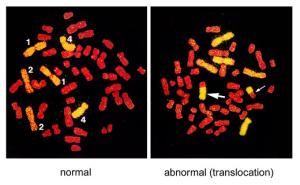
Lawrence Livermore developed a way to “paint” specific chromosomes to quickly identify chromosome damage.
Pipelining innovation
The University of California received more than $118 million in royalty and fee payments in 2014. One of the top five revenue-generating inventions was chromosome painting developed at Lawrence Livermore, which brought in more than $3.5 million in fees and royalties.
The ability to sort chromosomes using LLNL's high-speed sorter led to the development of chromosome painting, a rapid method to measure damage to specific chromosomes. The outcome of these biological studies was to measure the genetic effects of exposure to toxic chemicals and radiation.
In 2014, UC inventions generated a total of $118,243,000 in royalties and fees.

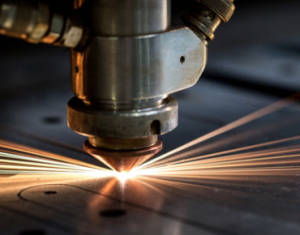
Lawrence Livermore engineers Eric Duoss (left) and Tom Wilson use an additive manufacturing process called direct ink writing to develop an engineered “foam” cushion to develop better helmets. Photo by George Kitrinos/LLNL
Tailor made for the head
LLNL and Authodesk have partnered to apply their respective skills to produce a new type of helmet that makes the current protective gear obsolete.
Combining Autodesk’s software and LLNL’s research on microstructures, the research is aimed at determining exactly what point of impact is responsible for a concussion.
The team is exploring the best substances for the job, e.g., considering the use of silicon to replace the foam pads most people have become accustomed to in helmets.

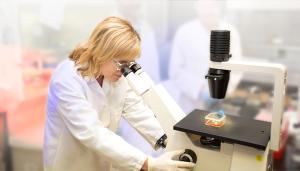
LLNL scientist Monica Borucki looks at cell lines used for viral propagation.
Chasing a virus
Lawrence Livermore Lab researchers have used new genetic sequencing technology and bioinformatics analysis to define how a novel and deadly respiratory virus changes when it passes from one host to another.
The Middle East Respiratory Syndrome Coronavirus (MERS-CoV), an RNA virus related to Severe Acute Respiratory Syndrome (SARS), can cause serious respiratory illness, fever, coughing and shortness of breath in carriers, and has killed roughly 40 percent of diagnosed patients. Since first being reported in Saudi Arabia in 2012, scientists have determined MERS likely originated in camels, but not much is known about how it is transmitted to humans or other animals.
Using ultra-deep sequencing and polymerase chain reaction tests, LLNL researchers obtained data from nasal samples of three camels infected with the human MERS virus. While only five mutations were detected in the virus' genome sequence, nearly 500 genetic variants were identified within the samples.

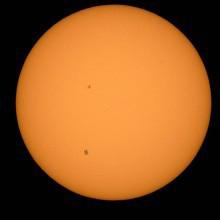
This colorful view of Mercury was produced by using images from the color base map imaging campaign during MESSENGER’s primary mission. These colors enhance the chemical, mineralogical and physical differences between the rocks that make up the planet’s surface. Image credit: NASA / Johns Hopkins University Applied Physics Laboratory / Carnegie Institution of Washington.
Paint it black
Scientists from Johns Hopkins University Applied Physics Laboratory have confirmed that Mercury’s crust is black from carbon that came to the surface deep from within the planet’s interior.
Through simulations and modeling, the Lab’s Megan Bruck Syal of Lawrence Livermore last year proposed that Mercury’s darkness was due to carbon that gradually accumulated from the impact of comets.
Using data from NASA’s MESSENGER mission, the Johns Hopkins team determined the carbon most likely originated deep below the surface, some of which was later brought to the surface by impact processes after most of Mercury’s current crust had formed.

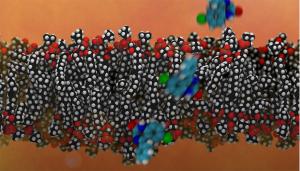
In a composite of two images, cyan-colored drug molecules are shown passing through a cell membrane. Graphic by Tim Carpenter/LLNL
It’s shaving time for drugs to act
Researchers at Lawrence Livermore are using LLNL’s world-class supercomputers to simulate the energy requirements for candidate drug molecules to permeate cell membranes — shaving weeks of compound testing by determining in advance how readily they’ll enter cells to perform their activity.
“Instead of having one [drug molecule] starting from one side of the membrane, you have it starting at a hundred different points through the membrane,” said Timothy Carpenter, a staff scientist in LLNL’s Biochemical and Biophysical Systems Group.
At each of these points, the simulation imposes an artificial force of varying degree on the molecule to keep it in place. By measuring the degree of fluctuations and movement of the molecules at each of these positions, the program can obtain the related energy levels, which can then be stitched together to generate a progressive energy profile.





